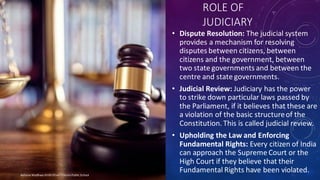Judicial decisions in religious disputes often become tools of political mobilization, challenging the judiciary’s ability to maintain neutrality. Balancing religious rights with the secular character of the Constitution is a significant challenge, especially when decisions are perceived to favor one community. Allowing cases involving disputed religious places to proceed undermines the basic principle of the Act, setting a precedent for future conflicts over places of worship. There is an urgent need to ensure adherence to constitutional principles and safeguard secularism.
The judiciary plays a vital role in resolving disputes over religious places while safeguarding the principles of secularism, equality, and justice enshrined in the Indian Constitution. However, this task is fraught with challenges such as balancing historical claims with contemporary rights, maintaining public order, addressing emotional sensitivities, and ensuring compliance with legal frameworks such as the Places of Worship Act, 1991.
These complexities demand a careful and impartial approach to uphold constitutional values. If you want to destroy a country, destroy its cultural identity. The country will automatically perish. This is what the foreign invaders who attacked India did. The Islamic invaders not only looted wealth but also demolished temples and religious places on a large scale to destroy India’s cultural and religious identity.
The aim of the British was also to weaken India and exploit its resources. Therefore, they also made every possible effort to weaken India’s cultural identity. The religious places destroyed by the invaders are not just religious symbols.

As an ancient civilization, India’s identity is not complete without them. Ayodhya, Kashi, and Mathura are some examples of this. After hundreds of years of slavery, Sanatan culture is being revived today. In the Kashi, Mathura, Sambhal, and Ajmer Dargah cases, there is an attempt to acquire the symbols of India’s cultural identity based on evidence and documents. Challenges faced by the judiciary in addressing disputes over religious places, such as ambiguity in the legal framework.
Although the Places of Worship Act, 1991 aims to stabilize the 1947 status of religious places, its provisions leave room for different interpretations, weakening its enforcement. The Allahabad High Court allowed cases like the Gyanvapi Masjid in 2022, interpreting the Act as allowing a survey to determine religious character.
Revisiting age-old grievances runs the risk of increasing communal tension, disrupting public order, and harming social unity. Judicial rulings in religious disputes often become tools for political mobilization, challenging the judiciary’s ability to maintain neutrality.
Balancing religious rights with the secular character of the Constitution is a significant challenge, especially when judgments are perceived to favor one community. Allowing cases involving disputed religious places to proceed undermines the basic principle of the Act, setting a precedent for future conflicts over places of worship.
There is an urgent need to ensure adherence to constitutional principles and safeguard secularism. The judiciary often balances competing religious claims to uphold the secular character of the Constitution (Articles 25-28). For example: In S.R. Bommai v. Union of India (1994), the Supreme Court declared secularism a fundamental feature of the Constitution, which strengthened the neutrality of the state in religious matters. This ensures that religious freedom (Article 25) does not infringe on the rights of others or public order. Courts examine disputes over religious places through historical records and evidence, focusing on constitutional principles over religious sentiments.
In the Ayodhya dispute (M. Siddique vs. Mahant Suresh Das, 2019), the Supreme Court relied on historical and archaeological evidence to deliver a balanced verdict while allocating alternative land to the affected party to maintain fairness. The judiciary protects religious structures recognized as cultural or heritage sites while ensuring constitutional compliance.
In Aruna Roy v. Union of India (2002), the Court emphasized the promotion of composite culture under Article 51A(f), which is relevant in disputes over heritage religious sites. Courts settle religious disputes with procedural fairness, ensuring that all parties are heard without prejudice.
In the Gyanvapi Masjid-Kashi Vishwanath Temple dispute, the judiciary emphasized procedural compliance in the collection and evaluation of evidence, thereby ensuring the principles of a fair hearing. In resolving disputes over religious sites, the judiciary must act as the guardian of the Constitution, ensuring that secularism and communal harmony remain paramount.
By reinforcing the principles of the Places of Worship Act, delivering timely and impartial judgments, and promoting conflict resolution mechanisms, the judiciary can build public confidence and prevent historical grievances from disrupting social peace. A forward-looking approach that safeguards India’s secular fabric is vital to maintaining unity in its diverse, pluralistic society.






